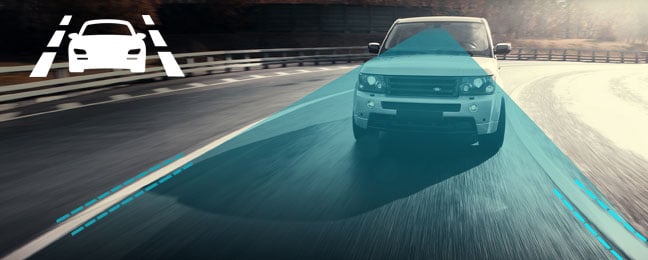

Mar 28 2018
Automakers have made great strides in increasing vehicle safety. Today's car shoppers will find many different advanced safety technologies, such as lane assistance technology, that are designed to reduce accidents and protect drivers, cyclists, and pedestrians.
Since automakers each have their unique branding for these safety features, it’s easy for vehicle shoppers, and even dealers and service providers, to get confused when comparing vehicle models across multiple brands. For example, while some safety features will simply alert drivers when required to adjust, others will actively take measures to mitigate collision with semi-autonomous functionality.
In this article, we’ve identified how the various lane assistance technologies differ from each other with some examples from the most current vehicle models.
Lane departure warning features are designed to alert drivers when their car is about to go out of the lane. A camera mounted on the windshield detects lane lines to provide in-time alerts if the driver begins to drift over the line.
Most cars accomplish the lane departure warning through a beep or a visual message on the dashboard (which some drivers may find distracting). Others, such as Ford, use vibration in the steering wheel to simulate the rumble strip in the breakdown lane. By beeping or vibrating the steering wheel to indicate a crossing of lane lines, the safety mechanism helps drivers stay focused.
This is a good feature for drivers who want smart road security features but want to retain the full driving experience. Though most manufacturers offer lane departure warning technology, it’s often used as part of the lane keeping system discussed in the next section.
Lane keep technology uses a windshield-mounted camera to detect lane lines, just like lane departure. Lane keep also strives to keep drivers within their lane, but it takes lane safety one step further than lane departure features.
Once the driver has started to drift, lane keep actually steers the car in the right direction to bring them back within the lane boundaries. Some vehicles apply the brakes on one side to gently nudge the car back into its line, but the majority of systems use steering wheel manipulation instead.
Some examples of automakers offering this technology include Ford’s “Lane-Keeping System,” Honda’s “Lane Keeping Assist System,” Volvo’s “Lane Keeping Aid,” and Subaru’s “Eyesight Lane Keep Assist and Sway Warning” – adding in a warning when the driver sways within the lines. Not every automaker includes the words “lane keep” within their product branding which can be confusing for the shopper. For example, Toyota calls this technology “Lane Departure Warning With Steering Assist.”
The type of assistance given varies widely by the type of vehicle. Some cars provide a slight nudge, while others are more aggressive in getting drivers to move over. For some drivers, this feature may feel too much like a step toward autonomous vehicles for their comfort.
Like the other features, road departure mitigation strives to keep the driver’s car on the road. It also uses a camera to detect lane boundaries. The main difference here is that road departure mitigation features take a wider view of the road, so they can spot objects outside of lane parameters that may impact the operation of a driver’s vehicle.
With this feature, it's possible to receive warning of parked cars, cyclists, or trees growing close to the road. This may be ideal for drivers who want the maximum amount of assistance with safe driving. However, road departure mitigation is only available on certain Honda and Acura models at this point.
All of these features are intended to be safety add-ons for drivers, rather than small self-driving cars. There is no substitute for an attentive driver!
Understanding the subtle differences between these features will help vehicle shoppers determine which level of lane assistance and other vehicle safety technologies are best for them. As a dealership, dealer service provider, or auto portal/research site, it’s essential that you provide your users and/or potential customers with an intuitive shopping experience that clarifies these questions.
Our PerfectFit® vehicle shopping software suite will help car shoppers wade through the range of automobiles on the market to find cars that have the features they want and need, then compare cars side by side. PerfectFit® normalizes auto safety features and places them into buckets so consumers can compare lane assistance features no matter what language the automaker uses to describe them. Help your customers find what they need with PerfectFit®.
Photo credit: Ivan Kurmyshov / Shutterstock.com